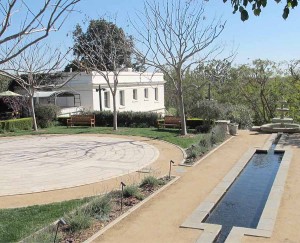Labyrinth offers a tranquil space in the bustling city
When I first told my friend Jersey about the Peace Awareness Labyrinth and Gardens, his first reaction was one of incredulity: “A labyrinth? Like with minotaurs?”

Eye of the storm · The Peace Awareness Labyrinth and Gardens, located only three miles from the University Park campus, is run by the Church of the Movement of Spiritual Inner Awareness. The church preaches the need of everyone to find their own way in the world. – Photo courtesy of the Movement of Spiritual Inner Awareness
Apparently, the original definition of the word “labyrinth” was the home of the ancient Greek creature.
Not surprisingly, the Peace Awareness Labyrinth does not house a minotaur, though it is home to something equally exotic: nature in the middle of Los Angeles.
The Peace Awareness Labyrinth is located on Adams Boulevard, a mere three miles from campus. Surrounded by slightly shabby houses in a primarily residential neighborhood, the PAL&G’s extravagant, gated property stands out.
The blatantly beautiful mansion serves as the focal point of the property. Upon our arrival, we were greeted by Bill, our “docent” and tour guide. We learned that the house, built in the early 1900s, has a longer history than the accompanying gardens, which weren’t added until the 1990s.
Though we were anxious to go outside, we politely accepted Bill’s offer of a house tour. Bill proudly boasted about the home’s oak floors and marble trimmings, but for those uninterested in interior decor (me), the “solarium” is undoubtedly the mansion’s coolest feature.
We rushed ahead of Bill into the second-floor solarium, which features ridiculously comfortable chairs and a nearly panoramic view of the garden below. Our chaperone gently explained that if someone had been meditating in the room, it would have been inappropriate for us to enter.
Originally built for Secundo Guasti, who owned the world’s largest winery at the time, the Italian Renaissance-style mansion was acquired in 1974 by the Church of the Movement of Spiritual Inner Awareness, fondly referred to as “the movement” by its members.
This “movement” itself is a purposefully vague take on religion — it mainly focuses on “soul transcendence” and is open to people of all religious backgrounds. The movement places a significant emphasis on self-reflection and knowing one’s self, through activities like meditation and walking the labyrinth.
“There’s no judgment here, the movement allows individuals to find their own way and be who they want to be,” said Bill.
John-Roger, who is memorialized in photos throughout PAL&G, founded the movement in 1968. It’s grown modestly since, and now claims 5,000 active members worldwide.
According to the movement’s website, PAL&G is meant to be “a place of peace for all.”
And if there’s anything stressed college students need, it’s peace. I’ve never meditated before, and even after the house tour, I still had no clue what a non-minotaur-housing labyrinth looked like, but if there’s one thing I wanted from my PAL&G experience, it was peace.
After much anticipation and a lengthy tour, we were finally allowed to enter the labyrinth and garden, located in the multi-layered backyard behind the mansion.
The garden is a hidden sanctuary in our urban area. I wandered around in disbelief, wondering how a bamboo-filled jungle appeared in Los Angeles. Fountains, a koi pond and exotic plants contributed to the garden’s soothing mood. Throughout the garden, people sat peacefully in meditation. Those who weren’t meditating admired the foliage quietly.
Yolanda, Bill’s wife and fellow member of the movement, briefed us on how to properly walk the labyrinth. The labyrinth is circular, with a white path weaving through it. There isn’t one certain way to walk the labyrinth, and like much of the movement’s beliefs, it’s the individual’s choice. Some people focus on a singular question while walking; others empty their minds in a state of moving meditation.
The labyrinth was modeled after the one at Chartres Cathedral in France, built around 1220. It’s about one-third of a mile long, which feels a lot longer during a slow-paced walk of self-reflection.
I wasn’t fully satisfied with my labyrinth experience. Granted, I entered with the big question of what I should do with my life, but I thought I’d have expected a major epiphany during my one-third mile walk.
My friend Alyssa suggested that I was asking too much of it, and that it’s better to simply enter with an open mind and see where your thoughts take you.
“You might feel lost, as if you’re in a maze, but have faith that you are on your path,” she said wisely.
Somehow, the labyrinth transformed my previously skeptical friends into insightful philosophers.
“Perhaps the labyrinth represents the passions and losses we will experience in life, yet ultimately signifies the tranquility we will find if we follow the path of our hearts,” said my friend Jon.
The labyrinth didn’t transform my mind, increase my self-awareness or anything else listed in the PAL&G’s brochures. I forgive the PAL&G and will probably return, just to escape city life for a day in the jungle.
Erin Rode is a freshman studying environmental engineering and print and digital journalism. Her column, “The Rode Less Traveled,” runs Thursdays.


I love this place … most peaceful place in Los Angeles … and it’s free.